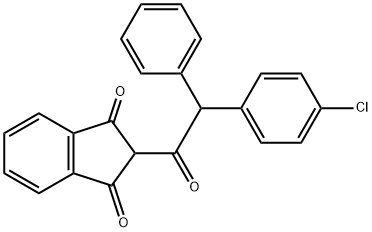클로로파시논 C화학적 특성, 용도, 생산
개요
Chlorophacinone is produced by condensation of 1-
phenyl-1-(4-chlorophenyl) acetone with dimethyl phthalate
in the presence of sodium methoxide (31).
This compound was introduced in 1961 and is now
widely used in Europe, the United States, and elsewhere.
It is used in baits against norway rats at a concentration
of 0.005–0.01%. Bait containing 0.025% chlorophacinone
gave a complete kill of house mice after a 7-d feeding
period but, in other tests, survivors were recorded following
10 and 21 days of feeding (5). Chlorophacinone acts as
an uncoupler of oxidative phosphorylation as well as an
anticoagulant (32), which is unusual among this group of
compounds.
화학적 성질
Chlorophacinone is a highly toxic crystalline
solid.
용도
Chlorophacinone (CPN) is an anticoagulant rodenticide widely used to control rodent infestations.
일반 설명
Crystals. Commercially available as oil concentrate and as dust concentrate. Used as an anticoagulant rodenticide. Chronic acting, multiple dose rodenticide.
공기와 물의 반응
Insoluble in water.
반응 프로필
Fire may produce irritating or poisonous gases.
건강위험
Chlorphacinon is highly toxic orally and by skin absorption. The probable oral lethal dose for humans is less than 5 mg/kg to 50 mg/kg, or between a taste (less than 7 drops) and 1 teaspoonful for a 150 lb. (70 kg) person.
화재위험
(Non-Specific -- Coumarin Derivative Pesticide, Solid, n.o.s.) Fire may produce irriating or poisonous gases. Runoff from fire control water may give off poisonous gases. Runoff from fire control or dilution water may cause pollution. When heated Chlorphacinon emits toxic fumes of chlorides.
농업용
Rodenticide: This material is an anticoagulant rodenticide used around livestock and also on crops such as artichokes. Some brands are labeled for use indoors and outdoors for the control of mice, rats, moles, muskrats, voles and vampire
bats. Not approved for use in EU countries. Registered for use in the U.S. There are 24 global suppliers.
상품명
AFNOR®; CAID®; DELTA®; DRAT RAT BAIT®; ENDORATS®; LIPHADIONE®; LM 91®; MICROZUL®; MURIOL®; PARTOX®[C]; QUICK®; RAMUCIDE®; RANAC®; RATOMET®; RAVIAC®; ROZOL®[C]; TOPITOX®
Safety Profile
Poison by ingestion and
skin contact. Human systemic effects by
ingestion: vascular changes. A pesticide. When heated to decomposition it emits
toxic fumes of Cl-.
잠재적 노출
Agricultural Chemical. This material
is an anticoagulant rodenticide. A potential danger to those
involved in its manufacture, formulation, and application
are at risk.
운송 방법
UN3027 Coumarin derivative pesticides, solid,
toxic, Hazard Class: 6.1; Labels: 6.1-Poisonous materials.
폐기물 처리
Incineration at high temperature with effluent gas scrubbing.
클로로파시논 준비 용품 및 원자재
원자재
준비 용품









